University Case Study: Clinical Analysis of Jonathan Yung's Healthcare
VerifiedAdded on 2023/01/17
|7
|1771
|56
Case Study
AI Summary
This case study analyzes the health condition of Jonathan Yung, a 16-year-old, who experienced critical health issues after a bubble soccer match. The paper applies the Levett-Jones clinical reasoning cycle, focusing on cue collection, analysis, and problem identification. Jonathan exhibited high blood pressure, increased pulse and respiratory rates, and elevated body temperature. The analysis considers his obesity, the hot and humid weather, and the strenuous physical activity as contributing factors. It explores the impact of homeostasis imbalance, the release of adrenaline, and the potential for ventricular gallop. The study references relevant literature to support the findings and suggests interventions such as ample hydration, balanced physical activity, and proper nutrition to address Jonathan's condition. The goal is to understand and manage his healthcare needs effectively.
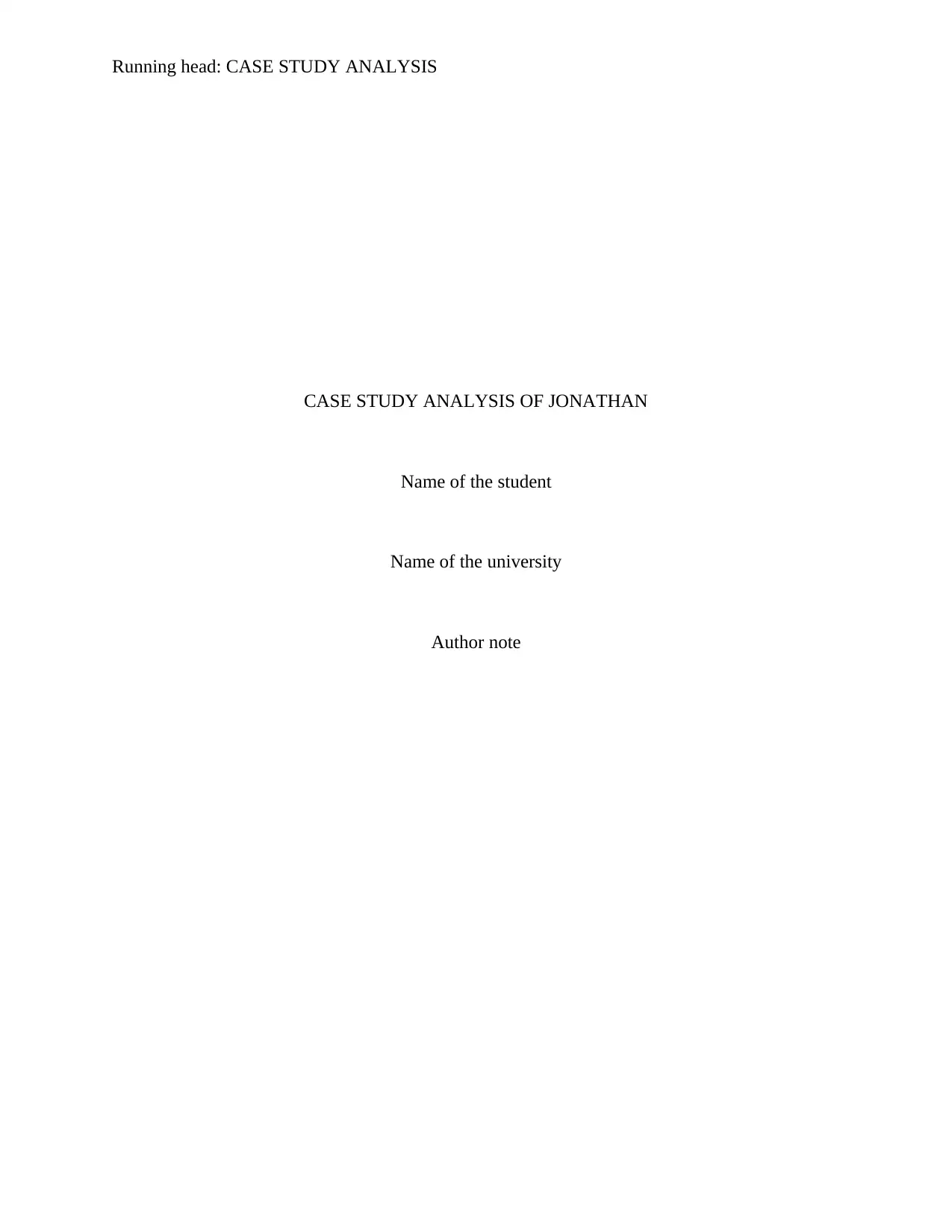
Running head: CASE STUDY ANALYSIS
CASE STUDY ANALYSIS OF JONATHAN
Name of the student
Name of the university
Author note
CASE STUDY ANALYSIS OF JONATHAN
Name of the student
Name of the university
Author note
Paraphrase This Document
Need a fresh take? Get an instant paraphrase of this document with our AI Paraphraser
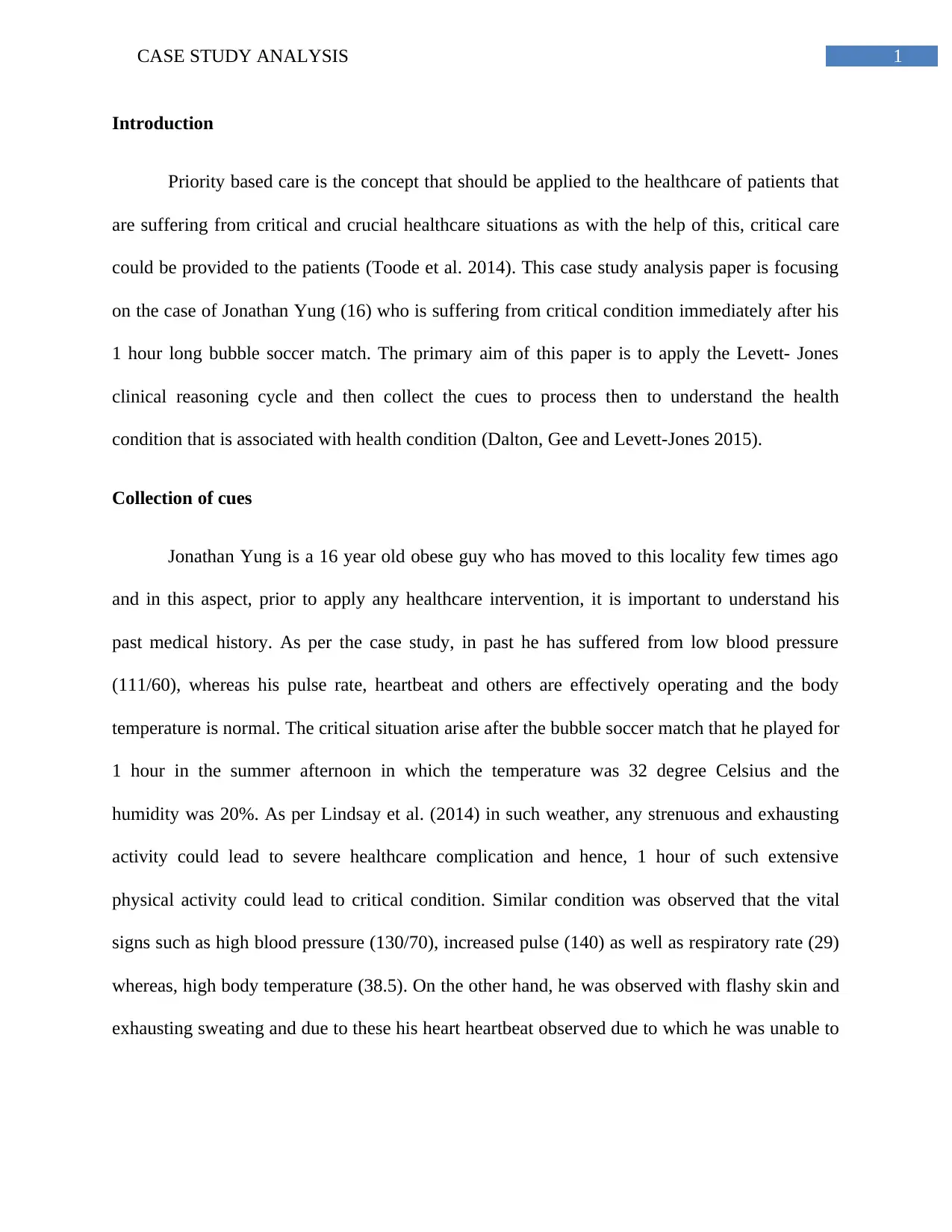
1CASE STUDY ANALYSIS
Introduction
Priority based care is the concept that should be applied to the healthcare of patients that
are suffering from critical and crucial healthcare situations as with the help of this, critical care
could be provided to the patients (Toode et al. 2014). This case study analysis paper is focusing
on the case of Jonathan Yung (16) who is suffering from critical condition immediately after his
1 hour long bubble soccer match. The primary aim of this paper is to apply the Levett- Jones
clinical reasoning cycle and then collect the cues to process then to understand the health
condition that is associated with health condition (Dalton, Gee and Levett-Jones 2015).
Collection of cues
Jonathan Yung is a 16 year old obese guy who has moved to this locality few times ago
and in this aspect, prior to apply any healthcare intervention, it is important to understand his
past medical history. As per the case study, in past he has suffered from low blood pressure
(111/60), whereas his pulse rate, heartbeat and others are effectively operating and the body
temperature is normal. The critical situation arise after the bubble soccer match that he played for
1 hour in the summer afternoon in which the temperature was 32 degree Celsius and the
humidity was 20%. As per Lindsay et al. (2014) in such weather, any strenuous and exhausting
activity could lead to severe healthcare complication and hence, 1 hour of such extensive
physical activity could lead to critical condition. Similar condition was observed that the vital
signs such as high blood pressure (130/70), increased pulse (140) as well as respiratory rate (29)
whereas, high body temperature (38.5). On the other hand, he was observed with flashy skin and
exhausting sweating and due to these his heart heartbeat observed due to which he was unable to
Introduction
Priority based care is the concept that should be applied to the healthcare of patients that
are suffering from critical and crucial healthcare situations as with the help of this, critical care
could be provided to the patients (Toode et al. 2014). This case study analysis paper is focusing
on the case of Jonathan Yung (16) who is suffering from critical condition immediately after his
1 hour long bubble soccer match. The primary aim of this paper is to apply the Levett- Jones
clinical reasoning cycle and then collect the cues to process then to understand the health
condition that is associated with health condition (Dalton, Gee and Levett-Jones 2015).
Collection of cues
Jonathan Yung is a 16 year old obese guy who has moved to this locality few times ago
and in this aspect, prior to apply any healthcare intervention, it is important to understand his
past medical history. As per the case study, in past he has suffered from low blood pressure
(111/60), whereas his pulse rate, heartbeat and others are effectively operating and the body
temperature is normal. The critical situation arise after the bubble soccer match that he played for
1 hour in the summer afternoon in which the temperature was 32 degree Celsius and the
humidity was 20%. As per Lindsay et al. (2014) in such weather, any strenuous and exhausting
activity could lead to severe healthcare complication and hence, 1 hour of such extensive
physical activity could lead to critical condition. Similar condition was observed that the vital
signs such as high blood pressure (130/70), increased pulse (140) as well as respiratory rate (29)
whereas, high body temperature (38.5). On the other hand, he was observed with flashy skin and
exhausting sweating and due to these his heart heartbeat observed due to which he was unable to
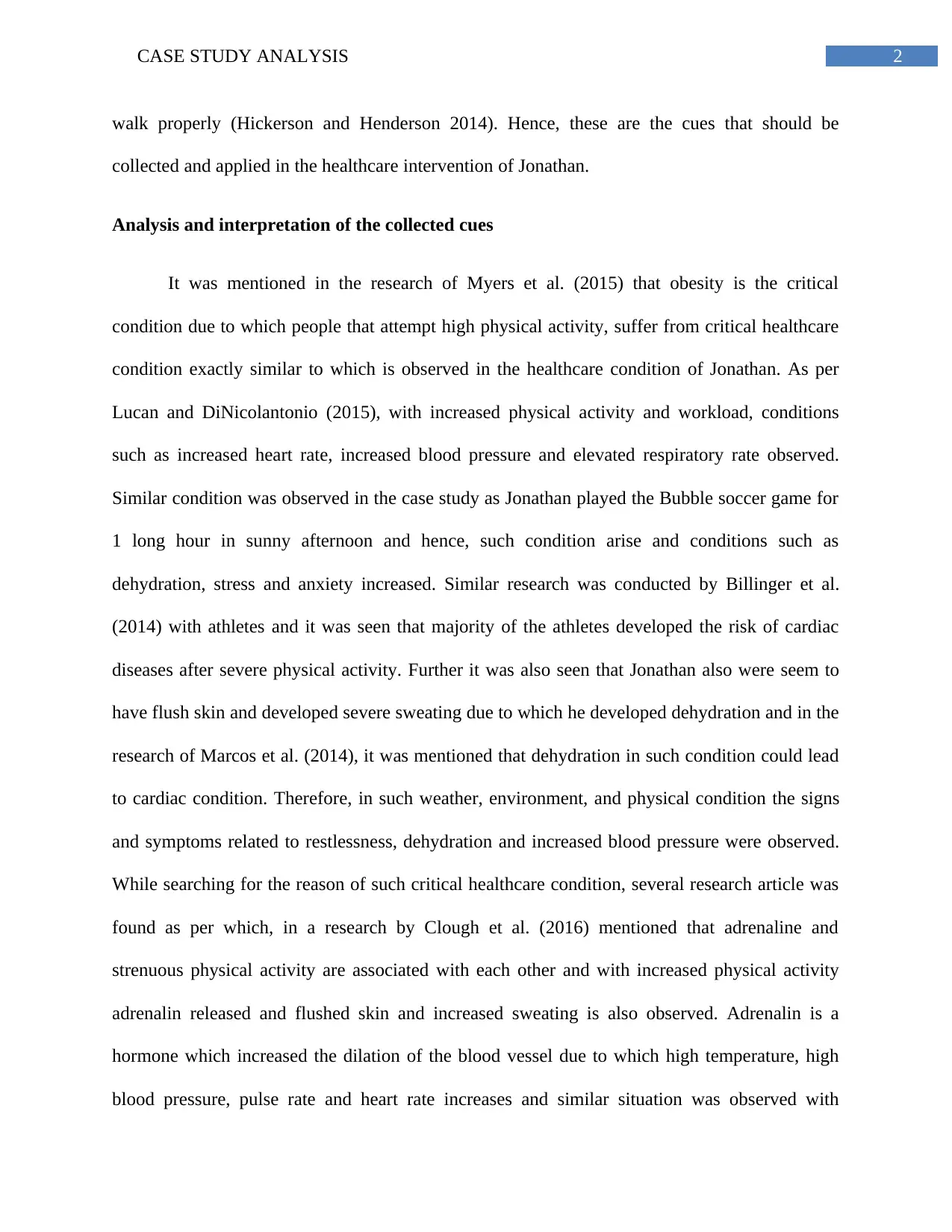
2CASE STUDY ANALYSIS
walk properly (Hickerson and Henderson 2014). Hence, these are the cues that should be
collected and applied in the healthcare intervention of Jonathan.
Analysis and interpretation of the collected cues
It was mentioned in the research of Myers et al. (2015) that obesity is the critical
condition due to which people that attempt high physical activity, suffer from critical healthcare
condition exactly similar to which is observed in the healthcare condition of Jonathan. As per
Lucan and DiNicolantonio (2015), with increased physical activity and workload, conditions
such as increased heart rate, increased blood pressure and elevated respiratory rate observed.
Similar condition was observed in the case study as Jonathan played the Bubble soccer game for
1 long hour in sunny afternoon and hence, such condition arise and conditions such as
dehydration, stress and anxiety increased. Similar research was conducted by Billinger et al.
(2014) with athletes and it was seen that majority of the athletes developed the risk of cardiac
diseases after severe physical activity. Further it was also seen that Jonathan also were seem to
have flush skin and developed severe sweating due to which he developed dehydration and in the
research of Marcos et al. (2014), it was mentioned that dehydration in such condition could lead
to cardiac condition. Therefore, in such weather, environment, and physical condition the signs
and symptoms related to restlessness, dehydration and increased blood pressure were observed.
While searching for the reason of such critical healthcare condition, several research article was
found as per which, in a research by Clough et al. (2016) mentioned that adrenaline and
strenuous physical activity are associated with each other and with increased physical activity
adrenalin released and flushed skin and increased sweating is also observed. Adrenalin is a
hormone which increased the dilation of the blood vessel due to which high temperature, high
blood pressure, pulse rate and heart rate increases and similar situation was observed with
walk properly (Hickerson and Henderson 2014). Hence, these are the cues that should be
collected and applied in the healthcare intervention of Jonathan.
Analysis and interpretation of the collected cues
It was mentioned in the research of Myers et al. (2015) that obesity is the critical
condition due to which people that attempt high physical activity, suffer from critical healthcare
condition exactly similar to which is observed in the healthcare condition of Jonathan. As per
Lucan and DiNicolantonio (2015), with increased physical activity and workload, conditions
such as increased heart rate, increased blood pressure and elevated respiratory rate observed.
Similar condition was observed in the case study as Jonathan played the Bubble soccer game for
1 long hour in sunny afternoon and hence, such condition arise and conditions such as
dehydration, stress and anxiety increased. Similar research was conducted by Billinger et al.
(2014) with athletes and it was seen that majority of the athletes developed the risk of cardiac
diseases after severe physical activity. Further it was also seen that Jonathan also were seem to
have flush skin and developed severe sweating due to which he developed dehydration and in the
research of Marcos et al. (2014), it was mentioned that dehydration in such condition could lead
to cardiac condition. Therefore, in such weather, environment, and physical condition the signs
and symptoms related to restlessness, dehydration and increased blood pressure were observed.
While searching for the reason of such critical healthcare condition, several research article was
found as per which, in a research by Clough et al. (2016) mentioned that adrenaline and
strenuous physical activity are associated with each other and with increased physical activity
adrenalin released and flushed skin and increased sweating is also observed. Adrenalin is a
hormone which increased the dilation of the blood vessel due to which high temperature, high
blood pressure, pulse rate and heart rate increases and similar situation was observed with
⊘ This is a preview!⊘
Do you want full access?
Subscribe today to unlock all pages.

Trusted by 1+ million students worldwide
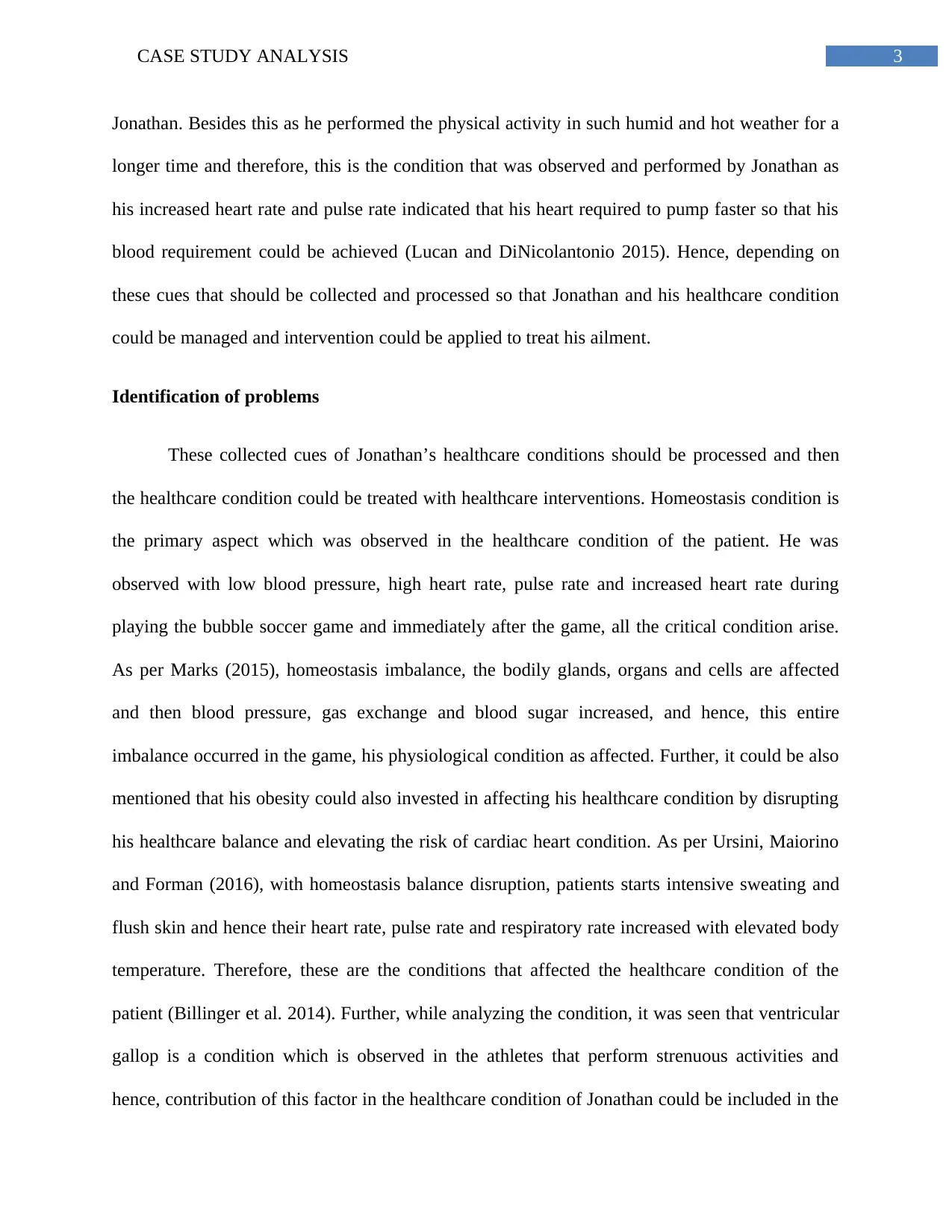
3CASE STUDY ANALYSIS
Jonathan. Besides this as he performed the physical activity in such humid and hot weather for a
longer time and therefore, this is the condition that was observed and performed by Jonathan as
his increased heart rate and pulse rate indicated that his heart required to pump faster so that his
blood requirement could be achieved (Lucan and DiNicolantonio 2015). Hence, depending on
these cues that should be collected and processed so that Jonathan and his healthcare condition
could be managed and intervention could be applied to treat his ailment.
Identification of problems
These collected cues of Jonathan’s healthcare conditions should be processed and then
the healthcare condition could be treated with healthcare interventions. Homeostasis condition is
the primary aspect which was observed in the healthcare condition of the patient. He was
observed with low blood pressure, high heart rate, pulse rate and increased heart rate during
playing the bubble soccer game and immediately after the game, all the critical condition arise.
As per Marks (2015), homeostasis imbalance, the bodily glands, organs and cells are affected
and then blood pressure, gas exchange and blood sugar increased, and hence, this entire
imbalance occurred in the game, his physiological condition as affected. Further, it could be also
mentioned that his obesity could also invested in affecting his healthcare condition by disrupting
his healthcare balance and elevating the risk of cardiac heart condition. As per Ursini, Maiorino
and Forman (2016), with homeostasis balance disruption, patients starts intensive sweating and
flush skin and hence their heart rate, pulse rate and respiratory rate increased with elevated body
temperature. Therefore, these are the conditions that affected the healthcare condition of the
patient (Billinger et al. 2014). Further, while analyzing the condition, it was seen that ventricular
gallop is a condition which is observed in the athletes that perform strenuous activities and
hence, contribution of this factor in the healthcare condition of Jonathan could be included in the
Jonathan. Besides this as he performed the physical activity in such humid and hot weather for a
longer time and therefore, this is the condition that was observed and performed by Jonathan as
his increased heart rate and pulse rate indicated that his heart required to pump faster so that his
blood requirement could be achieved (Lucan and DiNicolantonio 2015). Hence, depending on
these cues that should be collected and processed so that Jonathan and his healthcare condition
could be managed and intervention could be applied to treat his ailment.
Identification of problems
These collected cues of Jonathan’s healthcare conditions should be processed and then
the healthcare condition could be treated with healthcare interventions. Homeostasis condition is
the primary aspect which was observed in the healthcare condition of the patient. He was
observed with low blood pressure, high heart rate, pulse rate and increased heart rate during
playing the bubble soccer game and immediately after the game, all the critical condition arise.
As per Marks (2015), homeostasis imbalance, the bodily glands, organs and cells are affected
and then blood pressure, gas exchange and blood sugar increased, and hence, this entire
imbalance occurred in the game, his physiological condition as affected. Further, it could be also
mentioned that his obesity could also invested in affecting his healthcare condition by disrupting
his healthcare balance and elevating the risk of cardiac heart condition. As per Ursini, Maiorino
and Forman (2016), with homeostasis balance disruption, patients starts intensive sweating and
flush skin and hence their heart rate, pulse rate and respiratory rate increased with elevated body
temperature. Therefore, these are the conditions that affected the healthcare condition of the
patient (Billinger et al. 2014). Further, while analyzing the condition, it was seen that ventricular
gallop is a condition which is observed in the athletes that perform strenuous activities and
hence, contribution of this factor in the healthcare condition of Jonathan could be included in the
Paraphrase This Document
Need a fresh take? Get an instant paraphrase of this document with our AI Paraphraser
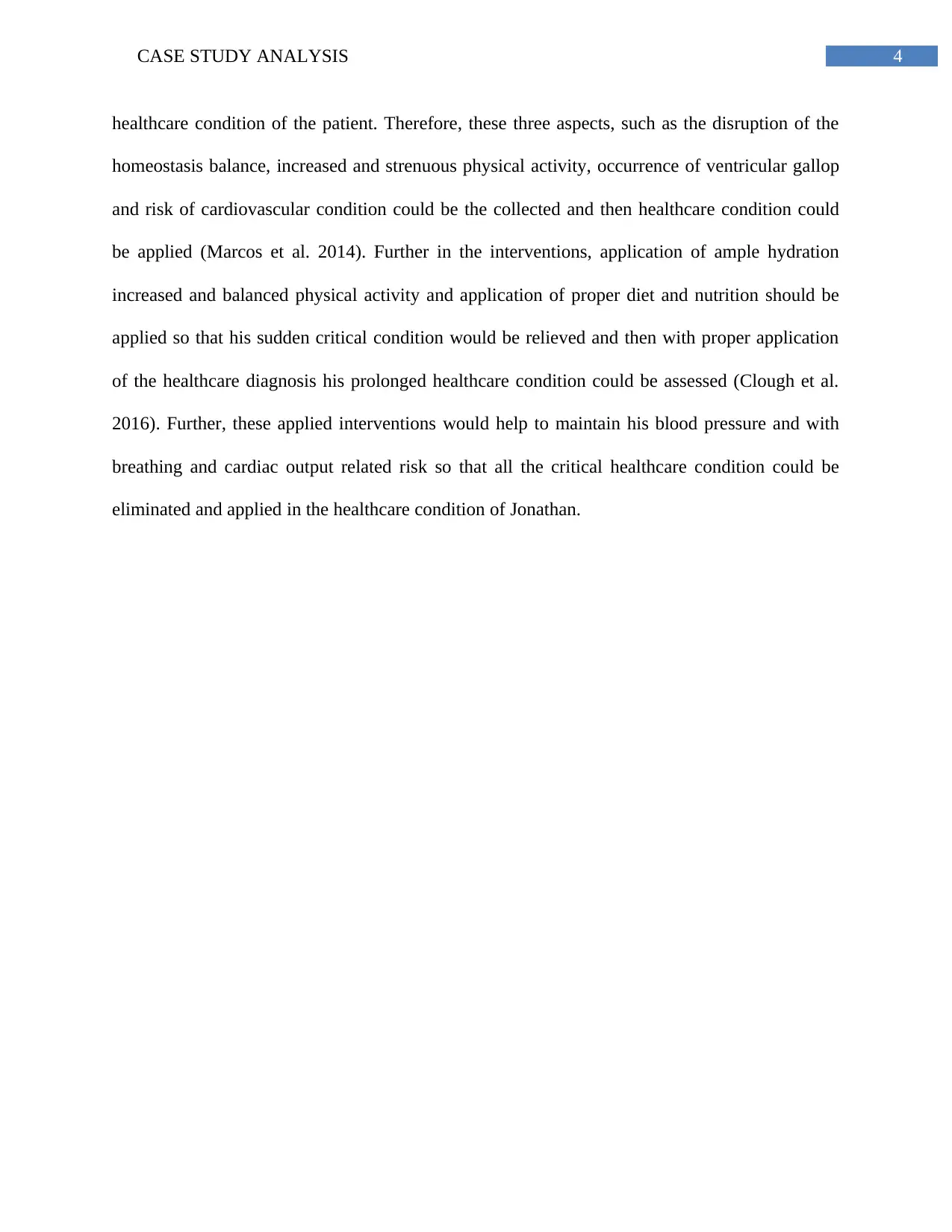
4CASE STUDY ANALYSIS
healthcare condition of the patient. Therefore, these three aspects, such as the disruption of the
homeostasis balance, increased and strenuous physical activity, occurrence of ventricular gallop
and risk of cardiovascular condition could be the collected and then healthcare condition could
be applied (Marcos et al. 2014). Further in the interventions, application of ample hydration
increased and balanced physical activity and application of proper diet and nutrition should be
applied so that his sudden critical condition would be relieved and then with proper application
of the healthcare diagnosis his prolonged healthcare condition could be assessed (Clough et al.
2016). Further, these applied interventions would help to maintain his blood pressure and with
breathing and cardiac output related risk so that all the critical healthcare condition could be
eliminated and applied in the healthcare condition of Jonathan.
healthcare condition of the patient. Therefore, these three aspects, such as the disruption of the
homeostasis balance, increased and strenuous physical activity, occurrence of ventricular gallop
and risk of cardiovascular condition could be the collected and then healthcare condition could
be applied (Marcos et al. 2014). Further in the interventions, application of ample hydration
increased and balanced physical activity and application of proper diet and nutrition should be
applied so that his sudden critical condition would be relieved and then with proper application
of the healthcare diagnosis his prolonged healthcare condition could be assessed (Clough et al.
2016). Further, these applied interventions would help to maintain his blood pressure and with
breathing and cardiac output related risk so that all the critical healthcare condition could be
eliminated and applied in the healthcare condition of Jonathan.
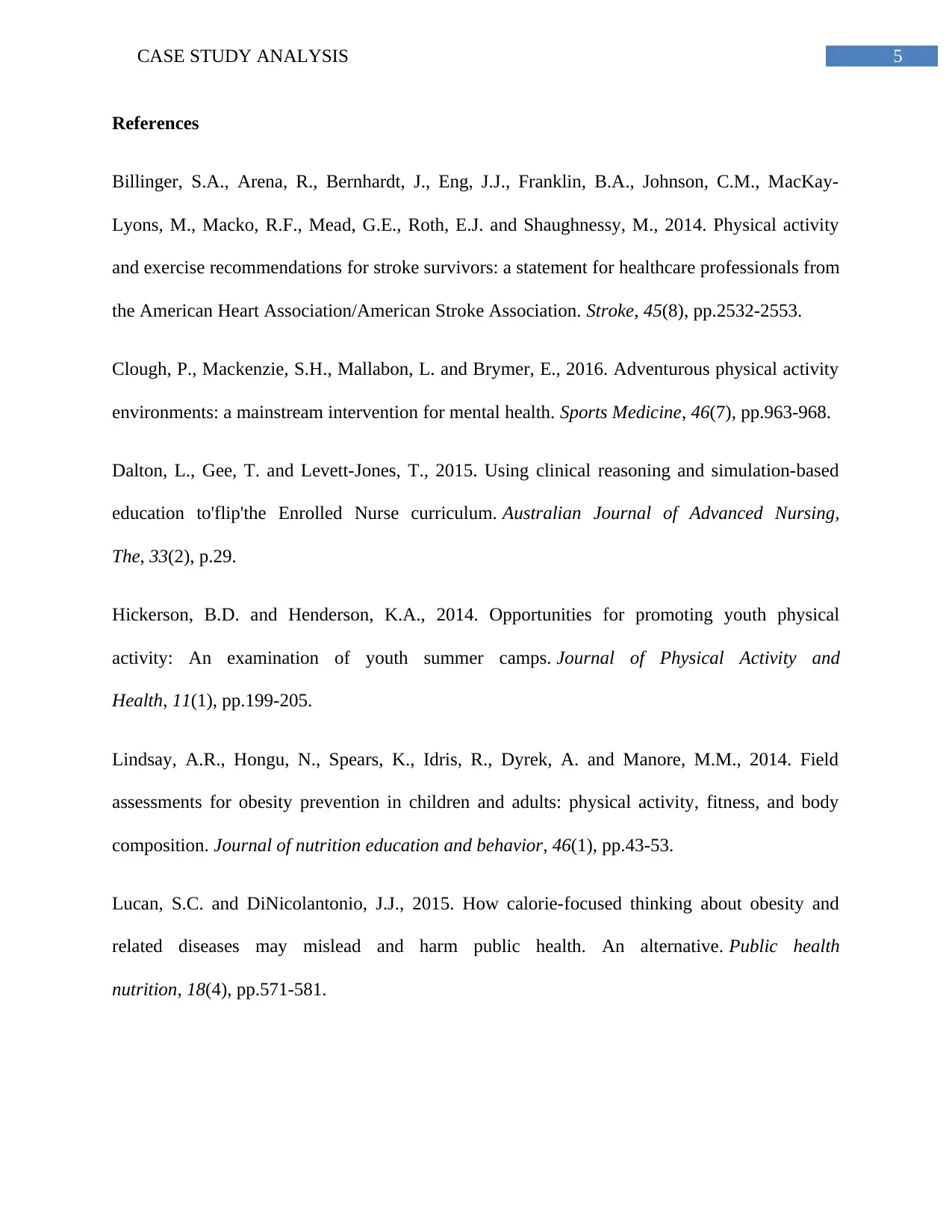
5CASE STUDY ANALYSIS
References
Billinger, S.A., Arena, R., Bernhardt, J., Eng, J.J., Franklin, B.A., Johnson, C.M., MacKay-
Lyons, M., Macko, R.F., Mead, G.E., Roth, E.J. and Shaughnessy, M., 2014. Physical activity
and exercise recommendations for stroke survivors: a statement for healthcare professionals from
the American Heart Association/American Stroke Association. Stroke, 45(8), pp.2532-2553.
Clough, P., Mackenzie, S.H., Mallabon, L. and Brymer, E., 2016. Adventurous physical activity
environments: a mainstream intervention for mental health. Sports Medicine, 46(7), pp.963-968.
Dalton, L., Gee, T. and Levett-Jones, T., 2015. Using clinical reasoning and simulation-based
education to'flip'the Enrolled Nurse curriculum. Australian Journal of Advanced Nursing,
The, 33(2), p.29.
Hickerson, B.D. and Henderson, K.A., 2014. Opportunities for promoting youth physical
activity: An examination of youth summer camps. Journal of Physical Activity and
Health, 11(1), pp.199-205.
Lindsay, A.R., Hongu, N., Spears, K., Idris, R., Dyrek, A. and Manore, M.M., 2014. Field
assessments for obesity prevention in children and adults: physical activity, fitness, and body
composition. Journal of nutrition education and behavior, 46(1), pp.43-53.
Lucan, S.C. and DiNicolantonio, J.J., 2015. How calorie-focused thinking about obesity and
related diseases may mislead and harm public health. An alternative. Public health
nutrition, 18(4), pp.571-581.
References
Billinger, S.A., Arena, R., Bernhardt, J., Eng, J.J., Franklin, B.A., Johnson, C.M., MacKay-
Lyons, M., Macko, R.F., Mead, G.E., Roth, E.J. and Shaughnessy, M., 2014. Physical activity
and exercise recommendations for stroke survivors: a statement for healthcare professionals from
the American Heart Association/American Stroke Association. Stroke, 45(8), pp.2532-2553.
Clough, P., Mackenzie, S.H., Mallabon, L. and Brymer, E., 2016. Adventurous physical activity
environments: a mainstream intervention for mental health. Sports Medicine, 46(7), pp.963-968.
Dalton, L., Gee, T. and Levett-Jones, T., 2015. Using clinical reasoning and simulation-based
education to'flip'the Enrolled Nurse curriculum. Australian Journal of Advanced Nursing,
The, 33(2), p.29.
Hickerson, B.D. and Henderson, K.A., 2014. Opportunities for promoting youth physical
activity: An examination of youth summer camps. Journal of Physical Activity and
Health, 11(1), pp.199-205.
Lindsay, A.R., Hongu, N., Spears, K., Idris, R., Dyrek, A. and Manore, M.M., 2014. Field
assessments for obesity prevention in children and adults: physical activity, fitness, and body
composition. Journal of nutrition education and behavior, 46(1), pp.43-53.
Lucan, S.C. and DiNicolantonio, J.J., 2015. How calorie-focused thinking about obesity and
related diseases may mislead and harm public health. An alternative. Public health
nutrition, 18(4), pp.571-581.
⊘ This is a preview!⊘
Do you want full access?
Subscribe today to unlock all pages.

Trusted by 1+ million students worldwide
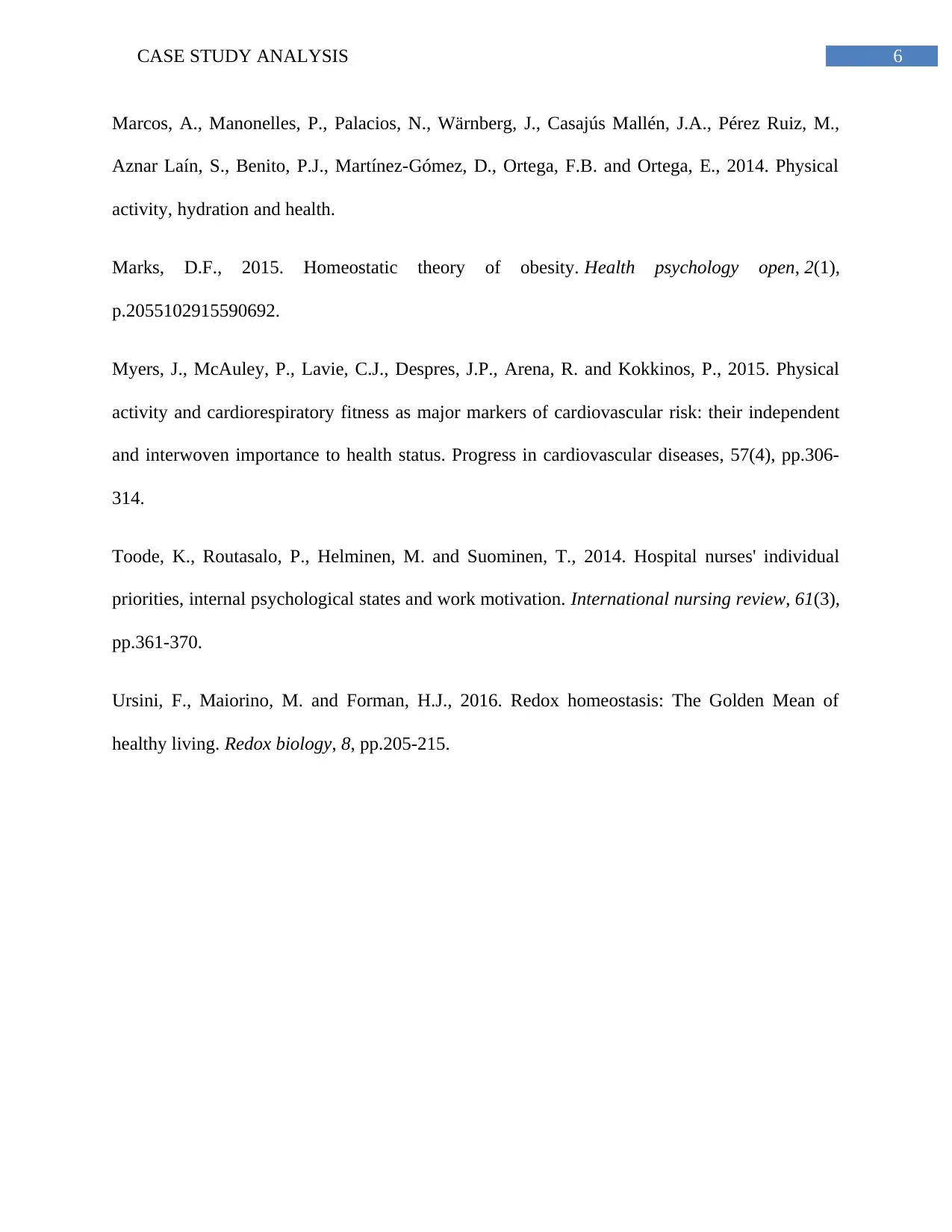
6CASE STUDY ANALYSIS
Marcos, A., Manonelles, P., Palacios, N., Wärnberg, J., Casajús Mallén, J.A., Pérez Ruiz, M.,
Aznar Laín, S., Benito, P.J., Martínez-Gómez, D., Ortega, F.B. and Ortega, E., 2014. Physical
activity, hydration and health.
Marks, D.F., 2015. Homeostatic theory of obesity. Health psychology open, 2(1),
p.2055102915590692.
Myers, J., McAuley, P., Lavie, C.J., Despres, J.P., Arena, R. and Kokkinos, P., 2015. Physical
activity and cardiorespiratory fitness as major markers of cardiovascular risk: their independent
and interwoven importance to health status. Progress in cardiovascular diseases, 57(4), pp.306-
314.
Toode, K., Routasalo, P., Helminen, M. and Suominen, T., 2014. Hospital nurses' individual
priorities, internal psychological states and work motivation. International nursing review, 61(3),
pp.361-370.
Ursini, F., Maiorino, M. and Forman, H.J., 2016. Redox homeostasis: The Golden Mean of
healthy living. Redox biology, 8, pp.205-215.
Marcos, A., Manonelles, P., Palacios, N., Wärnberg, J., Casajús Mallén, J.A., Pérez Ruiz, M.,
Aznar Laín, S., Benito, P.J., Martínez-Gómez, D., Ortega, F.B. and Ortega, E., 2014. Physical
activity, hydration and health.
Marks, D.F., 2015. Homeostatic theory of obesity. Health psychology open, 2(1),
p.2055102915590692.
Myers, J., McAuley, P., Lavie, C.J., Despres, J.P., Arena, R. and Kokkinos, P., 2015. Physical
activity and cardiorespiratory fitness as major markers of cardiovascular risk: their independent
and interwoven importance to health status. Progress in cardiovascular diseases, 57(4), pp.306-
314.
Toode, K., Routasalo, P., Helminen, M. and Suominen, T., 2014. Hospital nurses' individual
priorities, internal psychological states and work motivation. International nursing review, 61(3),
pp.361-370.
Ursini, F., Maiorino, M. and Forman, H.J., 2016. Redox homeostasis: The Golden Mean of
healthy living. Redox biology, 8, pp.205-215.
1 out of 7
Related Documents
Your All-in-One AI-Powered Toolkit for Academic Success.
+13062052269
info@desklib.com
Available 24*7 on WhatsApp / Email
![[object Object]](/_next/static/media/star-bottom.7253800d.svg)
Unlock your academic potential
Copyright © 2020–2025 A2Z Services. All Rights Reserved. Developed and managed by ZUCOL.





